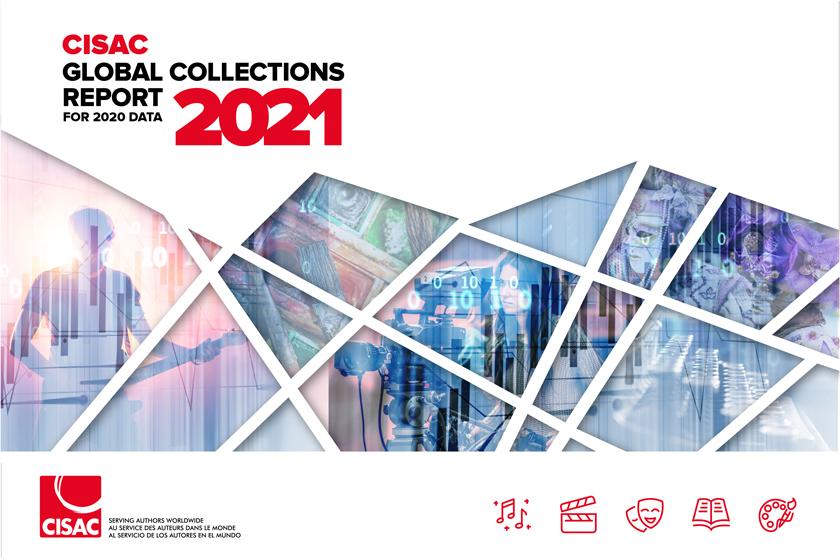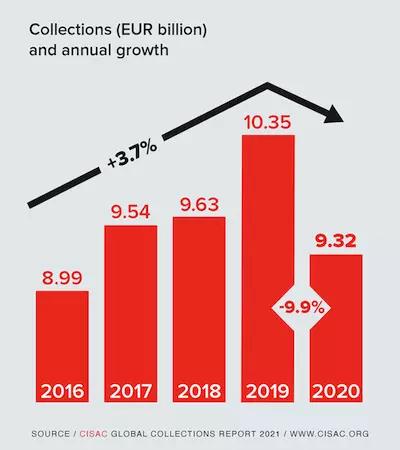
CISAC Global Collections Report shows creators’ royalties down by € 1 billion in 2020
Paris, October 27th - Worldwide royalty collections for creators of music, audiovisual, art, drama and literary works fell by 9.9% in 2020, with losses amounting to more than €1 billion as a result of the global pandemic.
Total collections fell to €9.32 billion as lockdown measures saw live and public performance revenue nearly halve across the world, according to the latest annual Global Collections Report published by CISAC (International Confederation of Societies of Authors and Composers).

The decline was partly mitigated by a strong rise in digital royalties, reflecting the sharp increase in audio and video streaming consumption worldwide and strong licensing activity by many of CISAC’s member societies around the world.
Key trends reported include:
- Live and public performance fell 45% to €1.6 billion, with live concert revenue down by an estimated 55%
- Digital collections rose 16.6% to €2.4 billion
- TV and radio broadcast, creators’ largest income source, fell 4.3% to €3.7 billion
- Music collections, comprising 88% of the total, declined 10.7% to €8.19 billion
Download the Key Highlights here
The Report analyses the varied impact of COVID-19 by region and sector, the vital role of long-term government support and direct measures for creators by societies, the continuing losses caused by lockdowns in 2021, and the outlook for recovery in 2022.
Download 2021 and Covid-19: Impact analysis here
CISAC members’ strategic responses to the pandemic are highlighted in case studies in Brazil, Croatia, France, Germany, Mexico, Senegal, South Korea, UK, US, and Vietnam.
Download COVID support: societies case studies here
The report shows how Covid has accelerated the shift to digital in the usage mix of creators’ royalties. But the large majority of creators are still earning marginal income from digital, which represents just over one quarter of collections globally.
Download the full Report here
Quotes from the Report
CISAC President Björn Ulvaeus: “Today, creators work in an inequitable eco-system. If we accept that the song – or the creative work of any repertoire – is the foundation of our creative industries, why do we then accept the near-invisibility of the creator in the commercial value chain? When I took on the presidency of CISAC in May 2020, the subjugation of the creator was already a massive issue. Then COVID struck, highlighting two things. First, that streaming is fast heading towards being the most important source of creators’ earnings in the future. And second, that streaming revenues, however fast they grow, are currently simply not providing a fair reward when shared across millions of individual recipients”.
CISAC Director General Gadi Oron: “After many years of steady growth, COVID has sent collections sliding downwards. Both mature and developing markets that are dependent on traditional income streams such as concerts, festivals, and exhibitions, suffered significant declines in 2020 that continue well into 2021. Increased digital collections have mitigated the fall in other income sources in many countries, and this is a tribute to the efforts of CISAC societies to change strategy, shift resources and step up digital licensing activity. Without a doubt, the pandemic has been a catalyst for change, accelerating a transition to digital that will not be reversed”.
CISAC Board Chair Marcelo Castello Branco: “The figures show that we have been hit by a seismic drop in revenues due to the crisis. But beyond early apocalyptical forecasts, the decline has been mitigated by our critical commitment to exploring new areas of revenue, in particular in the digital sector. As anticipated, unfortunately, we suffered a drop in revenue from live and public performance, and recovery in these fields will take longer than anticipated. There is still some uncertainty about when we will be able to return to normal, so we have to be cautious about forecasts”.
Barcella, singer/songwriter (France): “This is not a momentary crisis – it has carried on for nearly two years, and the journey to recovery for most is not quick and easy. Venues face an uncertain future and many are unsure if they can survive. For the experienced artists, mid-career, it is bad; but for the young artist starting out, deprived of an audience, it is far, far worse”.
